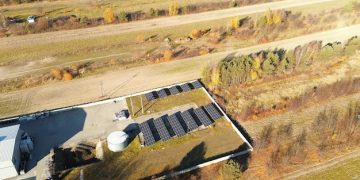Decoding the Inflation Reduction Act: Key Changes for Renewable Energy in 2025

Decoding the Inflation Reduction Act: 3 Key Policy Changes for Renewable Energy Project Developers in 2025 focuses on pivotal tax credit modifications, streamlined regulatory processes, and expanded funding programs, essential for adapting renewable energy strategies in the US market.
Navigating the evolving landscape of renewable energy development requires a keen understanding of legislative impacts. The Decoding the Inflation Reduction Act: 3 Key Policy Changes for Renewable Energy Project Developers in 2025 provides critical insight.
Understanding the Inflation Reduction Act (IRA) and its Significance
The Inflation Reduction Act (IRA) marks a significant turning point for renewable energy in the United States. Its provisions are designed to incentivize clean energy development and reduce carbon emissions, creating both opportunities and challenges for project developers.
This legislation is poised to reshape the renewable energy landscape, affecting everything from project financing to technology deployment. Understanding its key components is crucial for success in this evolving market.
Overview of the IRA’s Goals
The IRA aims to achieve several key objectives within the renewable energy sector:
- Significantly reduce carbon emissions across the US economy.
- Promote the growth and deployment of renewable energy technologies.
- Create new jobs and stimulate economic activity in the clean energy sector.
- Enhance energy independence and security.
Impact on Renewable Energy Project Developers
The IRA’s provisions will have a direct impact on how renewable energy projects are planned, financed, and executed. Project developers will need to adapt their strategies to take advantage of the new incentives and navigate the changing regulatory landscape.
This includes understanding the eligibility requirements for various tax credits, optimizing project design to maximize incentives, and engaging with government agencies to ensure compliance.

In conclusion, the IRA presents a transformative opportunity for renewable energy project developers. By understanding the Act’s key provisions and adapting their strategies accordingly, developers can play a crucial role in driving the transition to a cleaner, more sustainable energy future.
Key Policy Change 1: Modifications to Tax Credits
One of the most significant aspects of the IRA is its overhaul of tax credits for renewable energy projects. These changes are designed to provide greater financial incentives and encourage broader participation in clean energy development.
Understanding these modifications is essential for project developers looking to secure funding and optimize their project economics. The changes affect both the types of projects eligible for credits and the amount of the credits themselves.
Investment Tax Credit (ITC) and Production Tax Credit (PTC) Extensions
The IRA extends the ITC and PTC, providing long-term certainty for renewable energy project developers. This extension allows developers to plan projects with greater confidence, knowing that these crucial incentives will be available for years to come.
The extension also expands the scope of eligible technologies, including energy storage and other emerging clean energy solutions.
Direct Pay Provisions for Certain Entities
A notable change is the introduction of direct pay provisions for certain entities, such as non-profits, state and local governments, and tribal nations. This allows these entities to receive a direct payment from the government in lieu of tax credits, making renewable energy projects more accessible.
This provision is particularly beneficial for entities that do not have sufficient tax liability to utilize the credits, enabling them to invest in clean energy without the need for complex financing structures.
Incentives for Domestic Content
The IRA includes incentives for projects that utilize domestic content, encouraging the development of a domestic renewable energy supply chain. Projects that meet certain domestic content requirements are eligible for increased tax credits.
This provision aims to create jobs and stimulate economic activity within the United States, while also reducing reliance on foreign suppliers.

In summary, the modifications to tax credits under the IRA provide significant opportunities for renewable energy project developers. By understanding the specific requirements and incentives, developers can maximize their financial returns and contribute to the growth of the clean energy sector.
Key Policy Change 2: Streamlined Regulatory Processes
Navigating the regulatory landscape can be a significant hurdle for renewable energy projects. The IRA seeks to address this by streamlining certain regulatory processes and promoting greater efficiency in project approvals.
These changes aim to reduce project timelines, lower development costs, and create a more predictable environment for renewable energy investments. The focus is on improving coordination between federal agencies and simplifying permitting procedures.
Expedited Permitting for Renewable Energy Projects
The IRA includes provisions to expedite the permitting process for certain renewable energy projects, particularly those located on federal lands. This involves setting deadlines for permit reviews and improving coordination between agencies.
These changes are intended to reduce delays and uncertainty, making it easier for developers to move forward with their projects.
Enhanced Interagency Coordination
The IRA promotes enhanced coordination between federal agencies involved in renewable energy development. This includes establishing working groups and streamlining communication channels to address potential conflicts and resolve permitting issues more efficiently.
By improving coordination, the IRA aims to create a more cohesive and supportive regulatory environment for renewable energy projects.
Support for Environmental Reviews
The IRA also provides funding for environmental reviews of renewable energy projects, ensuring that these projects are developed in a sustainable and responsible manner. This funding supports thorough assessments of potential environmental impacts and the development of mitigation strategies.
This provision helps to ensure that renewable energy projects are not only economically viable but also environmentally sound.
In conclusion, the streamlined regulatory processes under the IRA are designed to facilitate the development of renewable energy projects by reducing delays, improving coordination, and ensuring environmental responsibility. These changes will contribute to a more efficient and predictable regulatory environment, encouraging greater investment in clean energy.
Key Policy Change 3: Expanded Funding Programs
In addition to tax credits and regulatory reforms, the IRA includes expanded funding programs to support renewable energy development. These programs provide grants, loans, and other financial incentives to help developers overcome financial barriers and accelerate project deployment.
These funding opportunities are available for a wide range of renewable energy technologies, including solar, wind, energy storage, and advanced grid infrastructure. The programs are designed to support innovation, reduce costs, and promote the widespread adoption of clean energy solutions.
Grant Programs for Renewable Energy Deployment
The IRA establishes several grant programs to support the deployment of renewable energy technologies, particularly in underserved communities. These grants provide direct financial assistance to help developers finance projects and reduce their reliance on private capital.
- Funding is targeted towards projects that benefit low-income communities and promote environmental justice.
- Grants are available for a variety of renewable energy technologies, including solar, wind, and energy storage.
- The programs prioritize projects that create local jobs and stimulate economic development.
Loan Programs for Renewable Energy Projects
The IRA expands existing loan programs to provide greater access to capital for renewable energy projects. These loans offer favorable terms and interest rates, making it easier for developers to secure financing and manage their project costs.
- Loan programs are available for both large-scale and small-scale renewable energy projects.
- Loans can be used to finance a wide range of project expenses, including equipment, construction, and operations.
- The programs prioritize projects that demonstrate innovative technologies and promote energy efficiency.
Support for Grid Modernization
The IRA includes funding to support grid modernization efforts, enhancing the ability of the grid to integrate renewable energy sources. This funding is used to upgrade transmission infrastructure, improve grid management systems, and promote the adoption of smart grid technologies.
- Funding is allocated to projects that enhance grid reliability and resilience.
- Support is provided for the development of advanced grid technologies, such as energy storage and demand response systems.
- The programs aim to create a more flexible and efficient grid that can accommodate increasing amounts of renewable energy.
In summary, the expanded funding programs under the IRA provide critical financial support for renewable energy project developers. By leveraging these grants, loans, and other incentives, developers can accelerate project deployment, reduce costs, and drive the transition to a cleaner, more sustainable energy future.
Adapting Renewable Energy Strategies for 2025
With the key policy changes enacted by the Inflation Reduction Act set to take full effect in 2025, renewable energy project developers must adapt their strategies to capitalize on the new opportunities and navigate the evolving landscape.
This requires a proactive approach, including staying informed about the latest regulatory updates, engaging with government agencies, and optimizing project designs to maximize the available incentives. Developers must also consider the long-term implications of the IRA and position themselves for sustained success in the clean energy sector.
Staying Informed on Regulatory Updates
Keeping up to date with the latest regulatory updates is essential for renewable energy project developers. This includes monitoring changes to tax credit eligibility requirements, permitting procedures, and funding program guidelines.
Project developers should subscribe to industry publications, attend conferences, and participate in stakeholder meetings to stay informed and gain insights from experts in the field.
Engaging with Government Agencies
Building strong relationships with government agencies is crucial for navigating the regulatory landscape and securing project approvals. This involves engaging with permitting agencies, funding program administrators, and other relevant government entities.
Project developers should proactively communicate with these agencies, providing detailed project information and addressing any concerns or questions that may arise.
Optimizing Project Designs for Incentives
To maximize the benefits of the IRA, renewable energy project developers should optimize their project designs to take full advantage of the available incentives. This includes incorporating domestic content, targeting underserved communities, and integrating innovative technologies.
Project developers should work closely with engineers, consultants, and other experts to identify opportunities to enhance project economics and qualify for additional incentives.
In conclusion, adapting renewable energy strategies for 2025 requires a proactive and informed approach. By staying up to date on regulatory updates, engaging with government agencies, and optimizing project designs for incentives, developers can position themselves for success in the evolving clean energy market.
Future Outlook for Renewable Energy Development Under the IRA
The Inflation Reduction Act is expected to have a profound and lasting impact on renewable energy development in the United States. As the IRA’s provisions take full effect in 2025 and beyond, the renewable energy sector is poised for significant growth, innovation, and diversification.
This long-term outlook presents both opportunities and challenges for project developers, investors, and policymakers. To fully realize the potential of the IRA, it is important to foster a collaborative and supportive environment that encourages investment, innovation, and sustainable development.
Expected Growth in Renewable Energy Capacity
The IRA is expected to drive significant growth in renewable energy capacity across the United States. This growth will be fueled by increased tax credits, streamlined regulatory processes, and expanded funding programs.
Analysts predict that the IRA will lead to a dramatic increase in the deployment of solar, wind, energy storage, and other renewable energy technologies, contributing to a cleaner, more sustainable energy future.
Innovation and Technological Advancements
The IRA is also expected to spur innovation and technological advancements in the renewable energy sector. The increased availability of funding and incentives will encourage developers to invest in new technologies and explore innovative approaches to project development.
This could lead to breakthroughs in energy storage, grid management, and other areas, further accelerating the transition to a clean energy economy.
Diversification of Renewable Energy Sources
As the renewable energy sector grows, it is expected to become more diversified, with a wider range of technologies and applications. The IRA supports the development of a diverse portfolio of renewable energy sources, including solar, wind, geothermal, hydropower, and biomass.
This diversification will enhance energy security, reduce reliance on fossil fuels, and create new economic opportunities across the United States.
In summary, the future outlook for renewable energy development under the IRA is bright. By fostering a collaborative and supportive environment, the United States can unlock the full potential of the IRA and accelerate the transition to a cleaner, more sustainable energy future.
| Key Aspect | Brief Description |
|---|---|
| 💰Tax Credits | Extended & modified Investment and Production Tax Credits. |
| ⚙️Regulations | Streamlined processes & interagency coordination for approvals. |
| ⚡Funding | Expanded programs for grants, loans, and grid modernization. |
FAQ Section
▼
The IRA is a US law designed to lower inflation, reduce carbon emissions, and lower prescription drug costs, with significant focus on clean energy incentives.
▼
The IRA provides tax credits, streamlines regulations, and expands funding programs, creating opportunities and challenges for project planning.
▼
Modifications include extensions to ITC and PTC, direct pay provisions, and incentives for projects using domestic content and labor standards.
▼
The IRA expedites permitting, enhances interagency coordination, and supports environmental reviews for faster and more efficient project approvals.
▼
Expanded funding programs include grants for deployment, loan programs for project financing, and support for grid modernization to integrate renewables.
Conclusion
In conclusion, decoding key changes from the Inflation Reduction Act in 2025 will greatly assist Renewable Energy Project Developers to modify energy strategies for sustained success in the clean energy sector.





